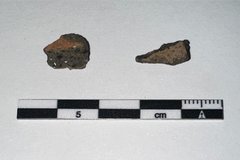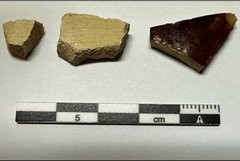Excavations continued in EU-4 and were completed by Friday. The lower levels of this unit (levels 8-11) had some snail shell fragments but no other cultural material. The soils contained several calcium carbonate nodules, which is expected of the soils close to the eroded limestone hardpan. This unit was excavated to a maximum depth of 122 cm (48 inches) below datum (Figure 1). Termination of the unit was due to the presence of hardpan across the base of the unit. There were no archaeological features, such as a wall foundation, encountered in the unit. The unit was documented with photographs and detailed plan view and profile maps.
Mission Gate and Lunette Archaeology - January 6

For next week, a final excavation unit will be laid out to explore the anomalies (limestone pavers and a caliche-rich deposit in the north profile) previously identified in EU-4. Excavation Unit 5 will be set up adjacent, and to the north, of EU-4 (Figure 2).

Lab work also continued throughout the week. During the processing of artifacts several Spanish Colonial period ceramics were identified. All artifacts were from EU-3. Guanajuato Polychrome (estimated date range 1800-1850) was initially produced in Guanajuato, Mexico and are commonly found throughout Spanish Colonial sites along the San Antonio River (Figure 3). Two Goliad Ware sherds were also identified in the lab (Figure 4). Goliad Wares (approximately date from 1720s to early 1800s) are Native-made pottery commonly found at Spanish missions in Texas. Also identified were Creamware and Rockingham Ware (Figure 5), both of which were produced in the latter half of the 1800s into the early 1900s.





